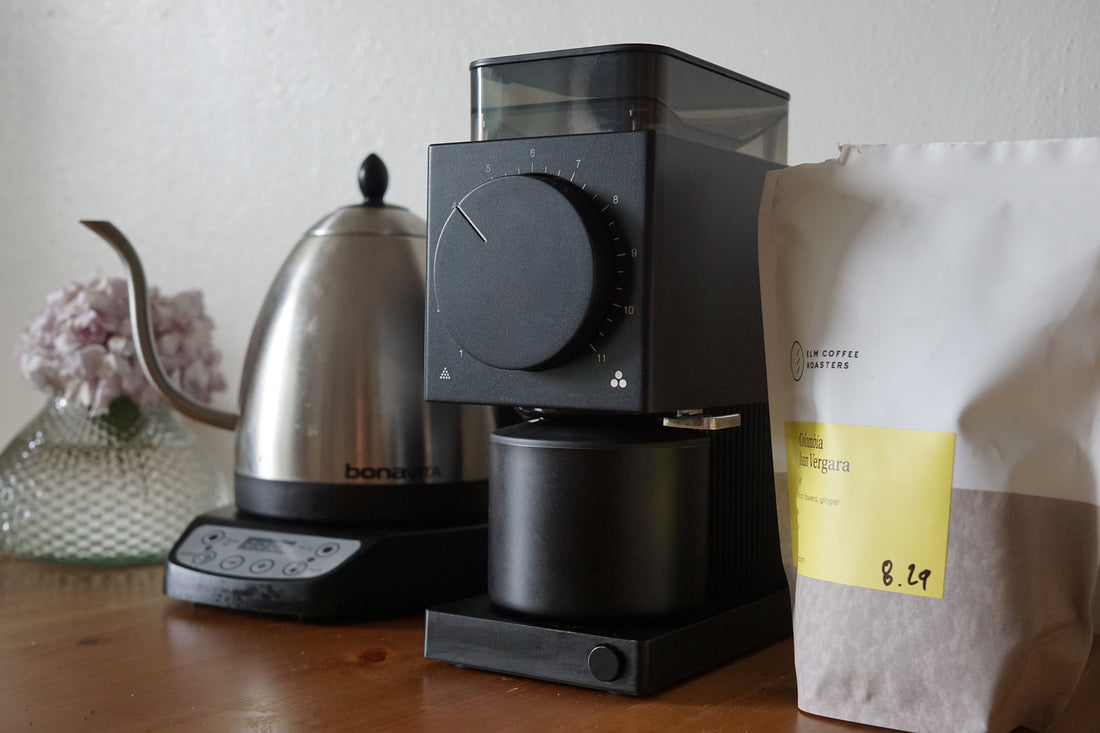
Living with the Fellow Ode
We’ve just started carrying the Fellow Ode grinder at Elm, as we’ve been very impressed with the results others have gotten from such a reasonably priced flat burr grinder. I’ve been using the grinder at home for the past few months, and I thought I would share my thoughts on living with the Fellow Ode. This is not a high intensity, scientific grinder review, with blind tasting, particle size distribution and refractometer usage, but rather more representative of an average user, who isn’t going to sweat over single percentage points of extraction at home.
First off, some context. I’m the head of production here at Elm, so while a huge part of my job is tasting coffee in intensive settings, my personal brewing setup is pretty light duty, since 5 days a week I have my coffee at work. I’ve been using the same entry level Baratza Encore conical burr grinder since college, and while it has served its purpose admirably, with no mechanical issues for a decade, it certainly left a lot to be desired in the cup.
My brews at home were about 75% “there.” If a coffee was really good in the shop, it’d be pretty good at home too, but inevitably missing a lot of that high end, punchy acidity, and definitely lacking flavor clarity and separation. Whereas I could clearly identify tasting notes like apricot or jasmine from batch brews made in the cafe, they were much more muddled at home. All of my brewing is done on a Hario v60 cone, since I have the Scott Rao v60 recipe practically memorized at this point. I do not do espresso at home, and probably never will, unless I win the lottery, which means the Ode is well suited for me as a filter brewing focused grinder.
The Fellow Ode makes a great first impression, aesthetically. It’s a serious piece of design, with its heavy, mostly-metal minimalist construction looking quite a bit nicer than my cooking oil splattered, all-plastic Baratza. There are a ton of thoughtful small additions, like a grind level guide on the hopper lid, a magnet to hold the dosing cup, and a satisfying grinds knocker.
When it comes to function, the little details add up. The first thing I noticed when I ground my first coffee was how much quieter the Ode was compared to my old grinder. The Encore would be loud enough to hear through the whole apartment, but with the Ode I can safely grind coffee knowing the sound is unlikely to escape the kitchen. I also really like the auto-stop function, as I’m always cooking breakfast while I make coffee. It's nice to be able to walk away and check on my eggs and not have to run back to shut the grinder off when it finishes. The grinder has both low retention and anti-static features, so it doesn’t leave old ground coffee in the burrs, nor spill them on your countertop. I really hate using fussy techniques like WDT and my old Baratza almost always had a small pile of coffee and chaff around its perimeter.
But here’s where things really matter: cup quality. Since fully seasoning the burr set (I’m using the standard Gen 2 set, with eyes on the SSP burrs in the future, as we use those in the cafe on all of our grinders) with 10 lbs of coffee, I can safely say that the Ode is well worth the price jump from the Encore. Cups I’ve brewed from the Ode have a much more structured flavor profile, with easily separated tasting notes and more present acidity. I’m able to grind to a finer level than on my Encore without encountering uneven extraction and the silty, chewy flavors that accompany that. I’ve yet to smuggle the refractometer home to test extraction, but by my palate, I can safely say my brews have been tasting significantly higher than those on the Encore. Whereas the Encore was 75% “there,” I would describe my brews so far on the Ode as more like 95%. I honestly still prefer our cafe’s batch brews, ground on an EK43, to any manual brew.
All these things considered, I think the Fellow Ode occupies a valuable space in the grinder market. At $360 retail, the Ode is essentially the optimal grinder for anyone with no home espresso aspirations. The grind quality it produces for that price point is excellent, and spending more money will only deliver diminishing returns: the only way to get a significant increase in your grind quality would be to buy something like a Mahlkonig EK43, which retails for an eye-watering ten times the price. And if you really do feel yourself hitting a glass ceiling with the Ode down the line, SSP burrs are right there, for a more reasonably priced upgrade.
And for the beginners out there, I would even recommend it as your first coffee grinder. Yes, it is a significantly steeper price than the Encore, but coffee brewing is a daily ritual, and you would be much better off buying once and crying once. When I got my Encore in the early 2010s, the enthusiast market was much smaller than it is today, and there really wasn’t a mid range offering like the Ode out there. The way I see it, you’re already spending over $20 a bag on specialty coffee, so you might as well spend an appropriate amount to get the most of what you’re brewing.
This all being said, I’m very excited that we’re now retailing the Fellow Ode, and can offer a grinding solution to our customers with no caveats. If you’re in the market, I would really strongly consider picking one up. We’ve got them in white and black at our Pioneer Square cafe, and online as well.
